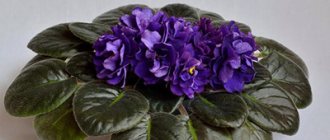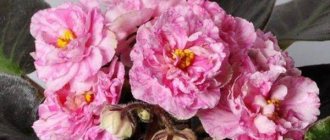What are there
David Austin is an English breeder who developed new varieties of roses by crossing Floribundas, hybrid teas and ancient species.
New varieties appeared in the 80s of the 20th century. They are not separated into a separate class; they belong to English roses, scrubs (bush types). Other names are Austin roses, “Austins”. The number of hybrids bred is more than 200.
Main differences
David Austin selected plants with certain criteria:
- The bud is rosette, pomp-shaped, cup-shaped.
- Rich aroma - intensity changes in the morning and evening hours, depending on weather conditions (sunny, cloudy weather).
- The bush is round, tall or medium, the shoots are straight or hanging.
Other types of buds: cup (shallow, deep, open), reverse-curved, cross-shaped rosette.
The number of petals is from 40 to 200, there is a velvet effect.
There are five types of aroma: musk, myrrh, fruity, tea and antique roses. Most species combine several types into one and change strength at different times.
The necessary criteria were selected from the mother plants:
- color (appearance of yellow, wine colors) – hybrid tea;
- pleasant smell (berry, fruit, citrus) against the background of the old ones;
- repeated, wave-like appearance of new buds, inflorescence of 5-10 pieces - floribunda.
Peculiarities
Austinkas have advantages over other flowering perennial plants that are easy to maintain with proper care:
- Abundant flowering all summer and autumn (without interruption or wavy).
- Can be planted in semi-shady, shady places.
- There is no growth if the plant is planted correctly (the neck is deepened by 3-4 cm).
- They rarely suffer from fungal diseases.
- Can be used for various purposes (cutting, mixed plantings, decorating fences, gazebos).
Disadvantages that appear if the plant is planted incorrectly or the location is chosen incorrectly:
- small size, faded color – bright sun for a long time;
- a large amount of precipitation - the buds do not open completely;
- poor re-blooming – little fertilizer;
- thin shoots can bend towards the ground.
How to choose and care
Seedlings can be purchased in stationary nurseries, rose gardens, and online stores. The cost will depend on the age of the seedling, the type of root system (closed or open), and the type of rootstock.
The “awning” rootstock is carried out on Rosa laxa (white roots), which does not produce wild growth if the plant is planted correctly. The Rosa canina (dog rose) rootstock produces a lot of growth that needs to be cut straight from the root.
Landing
When planting a plant, you need to follow certain steps:
- Choose high-quality material (preferably with a closed root system), based on reviews from trusted sellers.
- Choose a place – sunny, well-ventilated, spacious.
- Dig a hole (30-40 cm deep, 40-50 cm wide).
- Spill 4-5 liters of water until completely absorbed.
- Be sure to add a drainage layer (fine gravel, tile particles).
- Carefully distribute the earthen lump and cover it with nutritious soil.
- If the root system is closed, do not distribute the roots, plant them together with the lump.
- If the roots are without soil, cut them by a third, soak them in water, you can add a rooting agent to the water, or sprinkle them before planting.
The graft should cover 4-5 cm of soil. After planting, spill 3-4 liters of water.
Planting time is spring (warmed soil to +7-9⁰С), late April and early May for the Moscow region, middle zone. In warm regions, Crimea can be planted in the fall (mid-September to early November) - before the first frost (the plant should take root well).
Top dressing
In spring, nitrogen-containing fertilizer complexes are relevant - rapid growth of shoots and leaves. For good flowering - complexes containing potassium and phosphorus.
It is better to dissolve all fertilizers in water and pour them after abundant watering (the roots can burn if you do not water them before fertilizing). Stop feeding any species from August.
Under stressful conditions (lack of moisture, cold snap, heat, prolonged rains), sodium humate, epin, zircon can be used.
Trimming
It is advisable to prune (Russian conditions) in early spring, when you can see which shoots have frozen. Be sure to use sharp, high-quality pruning shears.
Trimming conditions:
- Cut out small, thin shoots.
- Remove all branches growing inside the bush.
- For a spreading bush, trim the ends (4-6 cm).
- Climbing look - keep the main long shoots, remove the internal, small ones.
- Compact - cut off two thirds, leaving 4-7 main shoots.
Re-tying buds - remove fading buds in time.
Detailed cutting instructions can be found on YouTube channels.
Additional care
Watering - 4-5 liters of cold water for each bush. The frequency of watering depends on the temperature and amount of precipitation (usually once every 7-10 days, in hot weather - once every 3-4 days).
Weeding and loosening with a radius of 25-30 cm are required. Can be covered with moss. mown grass in summer.
In winter - cover with spruce branches, after a temperature of -5⁰-7⁰С.
To prevent fungal (powdery mildew, spotting) diseases and aphid infestations, you need to use specialized preparations and folk remedies.
Reproduction
You can get larger quantities of a particular variety yourself using the main types of propagation:
- Cuttings - plant part of the shoot with buds (after spring pruning) in moist soil (greenhouse), use a rooting agent.
- Layerings - part of the lower branch is attached to the ground with a peg, sprinkled, left for 2-3 months, then cut off from an adult plant.
- Budding - an incision is made on the bark of the lower part, a part with a cultivated bud is inserted, experience is required.
Propagation of roses by seeds is not used due to poor germination of seeds over a long period of time.
The easiest way is cuttings, when in good conditions (warm and high humidity) the shoot gives roots.
Top 6 most beautiful floribunda roses for the middle zone
Do you want to turn your garden into a real piece of paradise, but don’t know how to do it? Plant floribunda roses on your plot: these plants, whose decorative properties are legendary, will surprise you with their ability to adapt to the conditions of the middle zone.
Floribunda roses are inferior to hybrid tea roses in terms of bud size, and it is difficult to call them extremely fragrant. However, despite this, experienced rose growers plant them on their plots with great pleasure. This reverent attitude is easy to explain: floribunda roses bloom very profusely and almost continuously throughout the season, and they are very easy to care for.
Another advantage of floribunda is its high adaptability to the climate of temperate latitudes. These plants not only are not afraid of severe frosts and prolonged rains, but also tolerate drought well and are resistant to diseases and pests.
To make it easier for you to decide, we have selected 6 of the most beautiful (according to professionals and ordinary gardeners) varieties of floribunda roses, which are ideal for growing in the middle zone.
Brothers Grimm (Gebruder Grimm)
Extraordinarily attractive and resilient - these words perfectly characterize roses of this variety.
The flowers gradually change their color (from red-yellow with a yellow reverse to crimson) and attract the attention of others throughout the season. Their bright color against the backdrop of shiny dark green foliage is a truly magnificent sight, and their delicate, subtle aroma is a real delight for people with a developed sense of smell.
The lush, tall (up to 90 cm) bush tolerates heat well and is not afraid of prolonged rains, strong winds, or bitter frosts. The plants are extremely resistant to diseases and pests; even the omnivorous aphid prefers to avoid them.
| Plant height (cm) | Bloom | Flower size (cm) | Aroma | Winter hardiness | Disease resistance |
| 80-90 | abundant, continuous (from June to frost) | 7-9 | weak | high | high |
Marie Curie
The shape of the flowers of roses of this variety is as unusual as the color. Their wavy central petals, pointed at the top, are soft apricot, and the outer petals are cherry pink.
Being next to this plant, you will be able to appreciate not only the beauty of its buds, but also their spicy aroma.
As a rule, the width of the bush exceeds its height. Therefore, this rose looks great as one of the main elements of the border (extended planting).
The Marie Curie variety is moderately resistant to powdery mildew and black spot. The plant tolerates frost well, is not afraid of rain, and feels good in hot weather. However, despite the “survivability” of the bushes, it is still better to plant them in places protected from drafts.
| Plant height (cm) | Bloom | Flower size (cm) | Aroma | Winter hardiness | Disease resistance |
| 70-90 | abundant, continuous from July to September | 8-9 | strong | high | average |
Paul Cezanne
It’s not for nothing that this variety was named after the French impressionist Paul Cézanne, a bright and extraordinary personality. Paul Cézanne's roses differ from their “compatriots” not only in their unusual variegated colors, but also in their delightful aroma, which contains notes of orange, pear, and cinnamon. This variety is considered one of the most fragrant among the representatives of the Rosehip genus.
The bushes are small and compact, so it is better to plant several of them in one place.
Despite its extreme decorativeness, the Paul Cezanne variety is resistant to disease; its bushes do not need to be covered in rainy weather.
| Plant height (cm) | Bloom | Flower size (cm) | Aroma | Winter hardiness | Disease resistance |
| 100-110 | abundant, continuous from June to September | 8-10 | strong | high | high |
Rotilia
Rotilia is clear proof that small roses can be much more attractive than their larger “sisters”. During the flowering period, a low compact bush is decorated with bright crimson-red flowers that are not afraid of either prolonged rains or scorching sun.
It is better to plant plants in a rose garden or border near the house. Large inflorescences will delight the eye and saturate the air with the subtle, refined aroma of rose hips.
Due to the fact that the bushes of this variety bloom beautifully, rarely get sick and tolerate frost well, it is one of the main contenders for the title of the best rose for the middle zone.
| Plant height (cm) | Bloom | Flower size (cm) | Aroma | Winter hardiness | Disease resistance |
| 50-60 | continuously, from July to September | 4-5 | weak | high | high |
Sangria
If you want to diversify your flower beds with brightly flowering plants, be sure to plant 2-3 bushes of the Sangria variety. The flowers of this plant have an unusual shape for roses - something between a pompom and a rosette. At the beginning of flowering, the buds are painted a rich pink color, over time they seem to fade in the sun and become pale pink or light purple.
Despite the external beauty of Sangria flowers, only people with a very sensitive sense of smell can catch their aroma.
The bushes are quite compact and not too tall, so they can be planted individually or in a group with other ornamental plants.
The variety tolerates both dry and rainy weather well, and is moderately resistant to powdery mildew and black spot.
| Plant height (cm) | Bloom | Flower size (cm) | Aroma | Winter hardiness | Disease resistance |
| 80-90 | June, August-September | 6-8 | weak | high | average |
Jubilee of the Prince of Monaco
A rose of this variety is worthy of the title of queen of the flower garden. Having bloomed its spectacular buds for the first time in June, it will delight you and your guests with lush, dazzlingly bright flowers that retain their shape well throughout the summer.
The plant is resistant to weather disasters: it tolerates heat and severe frosts well, and maintains its bush shape during periods of prolonged rain. Floribunda is not afraid of pests.
The bush of this rose is of medium height and does not grow, so the Jubilee Prince of Monaco variety is ideal for growing in groups and mixborders.
| Plant height (cm) | Bloom | Flower size (cm) | Aroma | Winter hardiness | Disease resistance |
| 70-80 | abundant, continuous (from June to frost) | 9-11 | weak | high | high |
Floribunda roses are truly unique plants: you can grow them as a bush or on a trunk, and if you wish, you can easily form tall specimens into a hedge. In any case, these plants will enliven the garden and bring you and your loved ones a lot of aesthetic pleasure.











